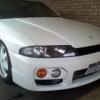Decisions Decisions
Announcements
-
Latest Posts
-
Yeah nice idea, you mean to suction it to the gauges? I hadn't thought of that.
-
By Dose Pipe Sutututu · Posted
A few suggestions: Do you have the option of retarding your exhaust cam gear to bring the power band over to the left? VCT would be turned off after you make peak torque, you see the power/torque will decay faster with it left on all the way to the limiter Once VCT is turned off, you'll find the motor will take a bit more timing being ramped in Send its mum, more boost! Of course, depends on your exhaust pressure. -
By TurboTapin · Posted
I was back on the dyno again yesterday after completely revamping my methanol injection system. I was making 440kw at 19psi. Great, this is more then I was making last summer with my old meth system at that pressure, and I figured it would be smooth sailing up to 30+psi. We continued increasing from there and by 25psi, I had only hit 455kw. Dyno sadly lost utility power at this point and I left. We seemed to be on course to hit the same power wall as last summer (477kw@27psi). This is a built RB25 S1 stroked to a 2.8. Built and ported head with Kelford 272/262 cams. Precision 6466 Turbo. Tuner last year believed the power wall is a mix of RPM limitations (Hydro lifters/Limit set at 7600RPM) and fueling. With my new meth system, we're seeing zero knock now but it still won't go up. What else can I do at this point? Here's my train of thought. - It's clear from the dyno graph that I would easily make power to 8500+RPM but I'm limited to 7600RPM. I could risk increasing my limiter, but hydro lifters have me worried. What are my options here besides going NEO head or solid lifter conversion? I'm rocking a 1.05AR turbine on my 6466. Would dropping down to a .84 help shift that power down in anyway? - We're only seeing roughly a 30kw difference at the top end with VCT on or off. Is this normal? I want to confirm VCT is working properly. - Should I look into other cam options? - Should I just keep increasing boost and see if she wakes up later on? I would expect to hit 600rwkw around 35psi with my 6466.
-





Recommended Posts
Create an account or sign in to comment
You need to be a member in order to leave a comment
Create an account
Sign up for a new account in our community. It's easy!
Register a new accountSign in
Already have an account? Sign in here.
Sign In Now